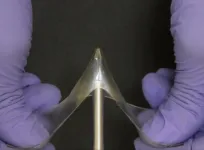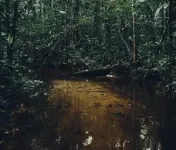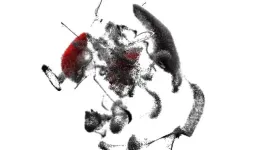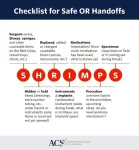(Press-News.org) Researchers have created a new class of materials called “glassy gels” that are very hard and difficult to break despite containing more than 50% liquid. Coupled with the fact that glassy gels are simple to produce, the material holds promise for a variety of applications.
Gels and glassy polymers are classes of materials that have historically been viewed as distinct from one another. Glassy polymers are hard, stiff and often brittle. They’re used to make things like water bottles or airplane windows. Gels – such as contact lenses – contain liquid and are soft and stretchy.
“We’ve created a class of materials that we’ve termed glassy gels, which are as hard as glassy polymers, but – if you apply enough force – can stretch up to five times their original length, rather than breaking,” says Michael Dickey, corresponding author of a paper on the work and the Camille and Henry Dreyfus Professor of Chemical and Biomolecular Engineering at North Carolina State University. “What’s more, once the material has been stretched, you can get it to return to its original shape by applying heat. In addition, the surface of the glassy gels is highly adhesive, which is unusual for hard materials.”
“A key thing that distinguishes glassy gels is that they are more than 50% liquid, which makes them more efficient conductors of electricity than common plastics that have comparable physical characteristics,” says Meixiang Wang, co-lead author of the paper and a postdoctoral researcher at NC State.
“Considering the number of unique properties they possess, we’re optimistic that these materials will be useful,” Wang says.
Glassy gels, as the name suggests, are effectively a material that combines some of the most attractive properties of both glassy polymers and gels. To make them, the researchers start with the liquid precursors of glassy polymers and mix them with an ionic liquid. This combined liquid is poured into a mold and exposed to ultraviolet light, which “cures” the material. The mold is then removed, leaving behind the glassy gel.
“The ionic liquid is a solvent, like water, but is made entirely of ions,” says Dickey. “Normally when you add a solvent to a polymer, the solvent pushes apart the polymer chains, making the polymer soft and stretchable. That’s why a wet contact lens is pliable, and a dry contact lens isn’t. In glassy gels, the solvent pushes the molecular chains in the polymer apart, which allows it to be stretchable like a gel. However, the ions in the solvent are strongly attracted to the polymer, which prevents the polymer chains from moving. The inability of chains to move is what makes it glassy. The end result is that the material is hard due to the attractive forces, but is still capable of stretching due to the extra spacing.”
The researchers found that glassy gels could be made with a variety of different polymers and ionic liquids, though not all classes of polymers can be used to create glassy gels.
“Polymers that are charged or polar hold promise for glassy gels, because they’re attracted to the ionic liquid,” Dickey says.
In testing, the researchers found that the glassy gels don’t evaporate or dry out, even though they consist of 50-60% liquid.
“Maybe the most intriguing characteristic of the glassy gels is how adhesive they are,” says Dickey. “Because while we understand what makes them hard and stretchable, we can only speculate about what makes them so sticky.”
The researchers also think glassy gels hold promise for practical applications because they’re easy to make.
“Creating glassy gels is a simple process that can be done by curing it in any type of mold or by 3D printing it,” says Dickey. “Most plastics with similar mechanical properties require manufacturers to create polymer as a feedstock and then transport that polymer to another facility where the polymer is melted and formed into the end product.
“We’re excited to see how glassy gels can be used and are open to working with collaborators on identifying applications for these materials.”
The paper, “Glassy Gels Toughened by Solvent,” will be published June 19 in the journal Nature. Co-lead author of the paper is Xun Xiao of the University of North Carolina at Chapel Hill. The paper was co-authored by Salma Siddika, a Ph.D. student at NC State; Mohammad Shamsi, a former Ph.D. student at NC State; Ethan Frey, a former undergrad at NC state; Brendan O’Connor, a professor of mechanical and aerospace engineering at NC State; Wubin Bai, a professor of applied physical sciences at UNC; and Wen Qian, a research associate professor of mechanical and materials engineering at the University of Nebraska-Lincoln.
The work was partially supported by funding from the Coastal Studies Institute.
A video explaining glassy gels, and demonstrating their properties, can be found at https://www.youtube.com/watch?v=LV-vgxxbNeY.
END
Researchers create new class of materials called ‘glassy gels’
2024-06-19
ELSE PRESS RELEASES FROM THIS DATE:
Tabulae Paralytica: Mapping the biology of spinal cord injury in unprecedented detail
2024-06-19
Scientists at EPFL have achieved a significant research milestone in the field of spinal cord injuries—mapping out the cellular and molecular dynamics of paralysis in unprecedented detail with their open-source project 'Tabulae Paralytica'. Grégoire Courtine and his team have integrated cutting-edge cell and molecular mapping technologies with artificial intelligence to chart the complex molecular processes that unfold in each cell after spinal cord injuries (SCI). Published in Nature, this seminal ...
When in drought: Researchers map which parts of the Amazon are most vulnerable to climate change
2024-06-19
In the late 2000s, Scott Saleska noticed something strange going on in the Amazon rainforest.
In 2005, a massive drought struck the region. Two years later, Saleska – a University of Arizona professor in the Department of Ecology and Evolutionary Biology – published surprising research that used satellite images to find that the drought resulted in more green growth in large swaths of the Amazon. On the other hand, field researchers saw plants brown and some die in response to the drought.
Research published today in the journal Nature reveals what caused the scientific mismatch. Shuli Chen, a doctoral degree candidate in ecology and evolutionary ...
Standardized OR handoffs significantly improve surgical communication and patient safety
2024-06-19
Key Takeaways
The introduction of a standardized handoff protocol substantially improved communication among OR staff, ensuring critical information was transferred consistently.
The enhanced communication reduced potential patient safety risks and highlighted the importance of standardized handoff tools in improving surgical outcomes.
CHICAGO (June 19, 2024) — A new study showcases a successful quality improvement program that significantly enhances surgical safety. By implementing a standardized handoff protocol, known as SHRIMPS, the study demonstrates how ...
Immune response study explains why some people don't get COVID-19
2024-06-19
Scientists have discovered novel immune responses that help explain how some individuals avoid getting COVID-19.
Using single-cell sequencing, researchers from the Wellcome Sanger Institute, University College London (UCL), Imperial College London, the Netherlands Cancer Institute and their collaborators, studied immune responses against SARS-CoV-2 infection in healthy adult volunteers, as part of the world's first COVID-19 human challenge study1. Not all exposed participants went on to develop a COVID-19 infection, ...
New research illuminates the ecological importance of gray wolves in the American West
2024-06-19
Corvallis, OR — A study published today in the journal BioScience sheds light on the importance of gray wolves in western United States. Led by William Ripple, a scientist at Oregon State University and the Conservation Biology Institute, the research delves into the implications of large predator absence on plant and animal communities, and ecosystem functions. It calls attention to “shifting baselines” wherein increasingly degraded conditions are viewed as reflecting the historical state of a system.
"By the 1930s, wolves were largely absent from the American West, including its national parks. Most published ecological ...
Forgotten predators: Ecological understanding is often marred by the exclusion of extirpated species
2024-06-19
New research published in the journal BioScience describes how the removal large predators is often unrecognized in ecological scholarship, creating an issue of "shifting baselines," with profound implications for restoration efforts.
A team led by researchers from Oregon State University, including co-lead authors William J. Ripple and Christopher Wolf, reviewed 96 published studies from 1955 to 2021 that were conducted in 11 national parks where gray wolves had been extirpated. Their analysis found that ...
Inclusive care: Strategies to support infant feeding for parents with disabilities through WIC
2024-06-19
Philadelphia, June 19, 2024 – Infant feeding, involving breastfeeding, formula feeding, and the introduction of solid foods, is crucial for parenting. Pregnant and postpartum individuals with intellectual and developmental disabilities face challenges in infant feeding compared to parents without intellectual and developmental disabilities, often due to ableism and inaccessible care. The Special Supplemental Nutrition Program for Women, Infants, and Children (WIC) program, a federal nutrition initiative, can address these disparities by offering inclusive and accessible support and counseling.
A recent research article in the Journal of Nutrition Education and Behavior, published ...
Computer modelling shows where Arizona’s winter precipitation originates
2024-06-19
The Sun Corridor in Arizona in the semi-arid Southwestern U.S. is a land of seeming unlimited growth that is constantly colliding with physical constraints. It is mountainous but also home to a large valley that includes one of the fastest growing metropolitan areas in the U.S.
While experiencing explosive growth, the Phoenix metropolitan area faces an uncertain future due to prolonged drought and fluctuating seasonal water availability. Planning for the future, especially in terms of water, ...
STUDY: Sourcing genomically diverse seedlings to create climate-change resilient forests brings optimism for partnerships between science and practice
2024-06-19
The roots of the project formed during a CASRI conference in 2018 when experts from various organizations learned about red spruce genetic research being conducted by Keller’s lab and collaborators at University of Maryland with funding by the National Science Foundation. The group saw an opportunity to join forces to take an on-the-ground approach to utilizing the genetic data for red spruce restoration. In 2019, funding from the Wildlife Conservation Society’s Climate Adaptation Fund enabled this group to pursue science-informed restoration at scale.
“Science-informed ...
Could auto-antibodies be linked to severe COVID-19?
2024-06-19
Even though COVID-19 manifests as a mild and short-lived disease in most people, some suffer extremely severe symptoms; in the worst cases, these patients die due to complications such as respiratory failure or thromboembolism. It is well-known that factors such as age and underlying medical conditions like diabetes or immunodeficiencies increase vulnerability to severe COVID-19. However, some patients still experience severe COVID-19 without any apparent reason.
One possible explanation may lie in auto-antibodies, which are antibodies that erroneously target specific proteins produced by one’s own body. In normal circumstances, type I interferons ...







